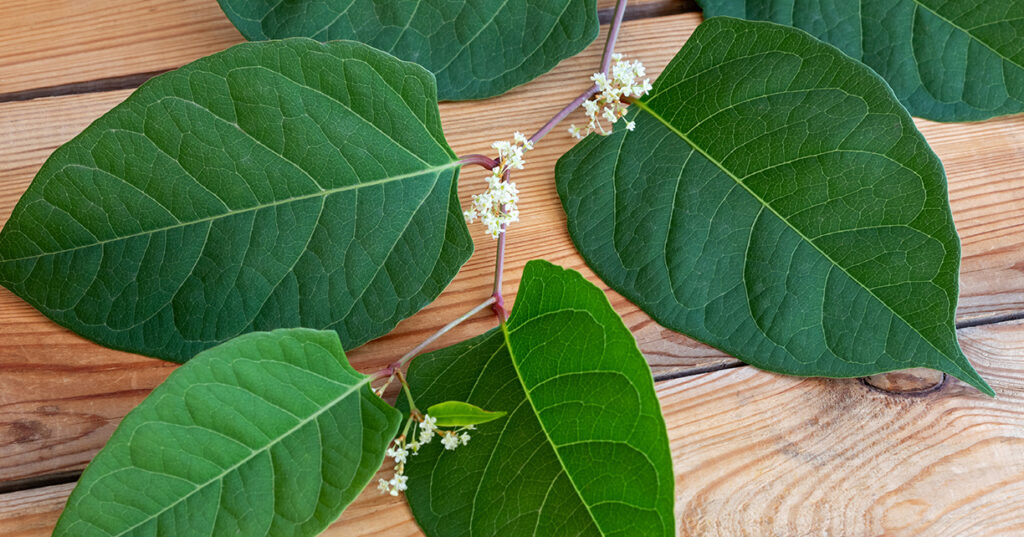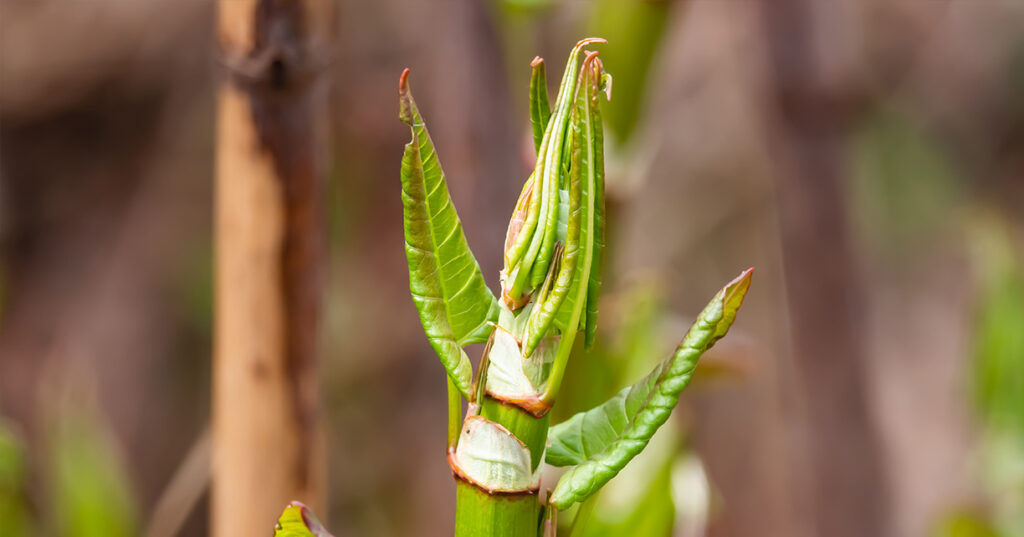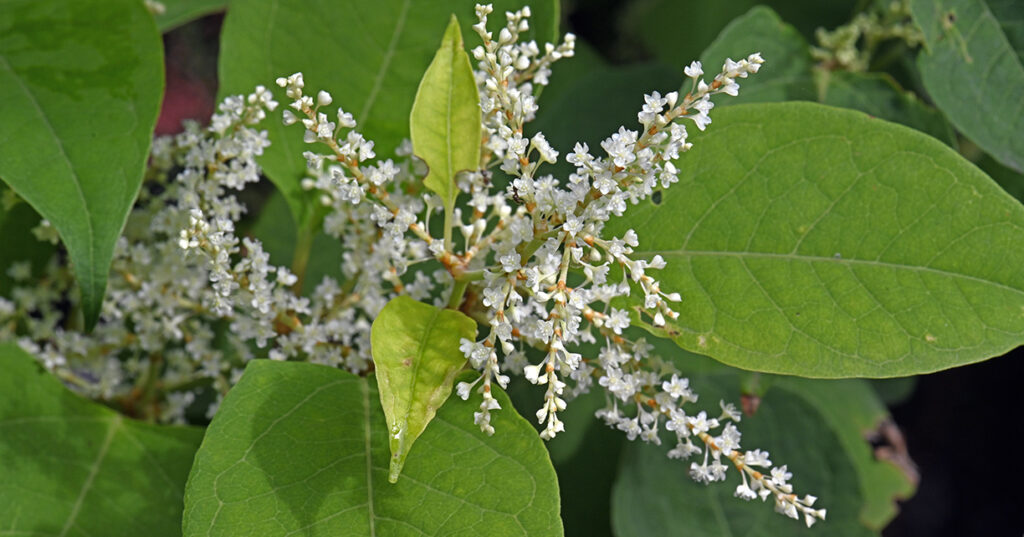Invasive Japanese Knotweed Also Makes a Delicious Dish

Japanese knotweed, also known as polygonum cuspidatum, is an invasive plant species sprouting up all across the state of Connecticut. The species is particularly fast growing and dense, shading out native plants and reducing wildlife habitat and biodiversity. It is especially harmful in river areas due to the fact that it can withstand flooding and has a large root system that can extend 45-60 feet, leading to the creation of a monoculture. In addition, Japanese knotweed is “reportedly allelopathic, it produces compounds that inhibit the growth of other plants.” The species commonly invades roadsides, wetlands, and stream banks that get plenty of sun, clearly preferring environments that are wet and sunny.

How to Identify Japanese Knotweed
Japanese knotweed is a multi-stemmed perennial shrub that can reach a height of 10 feet or more. The long green stems are hollow and are sprinkled with red or purple flecks. Similar to bamboo, the stem is raised at the nodes, or at the intersections of branches. It is also highly identifiable by its small lacey white flowers, which usually bloom in late summer. In the following season with the onset of frost, the plant then turns a distinct coppery brown and dies.
It is important to differentiate Japanese knotweed from other look-alike plants. Most notably, Japanese knotweed resembles another invasive species in Connecticut called giant knotweed. Giant knotweed is much larger and can be distinguished by examining the leaves. While Japanese knotweed has simple oval-shaped leaves with squarish bases and pointed tips, giant knotweed has heart shaped leaves. The species also produces greenish flowers, not white. Unfortunately, the two species have hybridized in the wild to create Bohemian knotweed, which can be even more problematic of an invasive species than either parent plant.
Control and Management
It is recommended that Japanese knotweed should be prevented from establishing itself in the first place. Obviously, this is important in order to decrease the growth of the species. This includes restricting the transport of the plant across state lines and preventing the regrowth of its seeds. Young plants that have grown from the seeds can be pulled, but it is important to remove everything, including roots and rhizomes. Any fragments that are half an inch or larger can lead to regrowth. However, digging up the roots of the larger grown plants, may actually help the knotweed further spread through the rhizomes. To avoid the use of chemicals, the small stands can be cut below the first node, before the plant flowers, and repeatedly until the plant starves. As a last resort, the stems can be cut and painted with herbicide particularly during the late summer or early fall when the plant is receiving the most nutrients. It is crucial that you use products specifically formulated for working near water and you may even require a permit. CT DEEP has a fact sheet with instructions on the CIPWG website. In general, the most important part in removing large stands of Japanese knotweed is controlling the rhizomes. Nonetheless, there is still another option when it comes to the removal of Japanese knotweed – eating it.

Turning Knotweed into a Delicious Dish
Calling all invasivores (those who eat invasive species of plants and animals) and anyone who is interested in trying some new recipes while helping to improve the biodiversity of the environment! Surprisingly, the young shoots of Japanese knotweed are edible and can be harvested starting in April when it usually starts sprouting. There are a variety of ways to prepare this invasive plant for consumption. The stems can be boiled and served similar to asparagus. It can also act as a substitute for “rhubarb or used to make jam by boiling the rind with sugar and pectin.” The hollow green stems, segmented like bamboo, have a taste comparable to rhubarb: tart, crunchy, and juicy. The different ways to prepare this plant for eating are endless. Many chefs have included knotweed in a variety of dishes, such as a jam at the center of a rolled almond cake, pickled in water, vinegar, and salt and sprinkled over a salad, or even sautéed in oil as a side dish. Japanese knotweed can even be turned into bread!
In New Haven, CT, Miya’s Sushi restaurant, which has been called the first sustainable sushi restaurant and has won a James Beard Award, offers an “invasive species” menu. Chef Bun Lai, known for his sustainable and innovative meals, uses Japanese knotweed in several of his dishes. The current menu items that utilize Japanese knotweed include Miso Wild “The Healthiest Soup in the World,” Knotweed Lemonade, Pickled Japanese Knotweed, and Forest Tea. Chef Bun Lai has also used the leaves of the plant to make knotweed chips. Since mature knotweed leaves are too tough to eat even when boiled or sautéed, Lai found a different way to make the plant leaves delicious to eat. To make these chips, he kimchee-pickles the knotweed leaves with salt, cayenne pepper, kelp, garlic, and ginger. After fermentation, they are fried into chips or tempura. “Rather than ridding knotweed by using carcinogenic herbicide, which is commonly how it’s done, eating it is far healthier for human and overall planetary health,” explained Lai in an article featured in The Cook’s Cook.
There are many ways to combat the growth of invasive species in Connecticut. With a plant as problematic and pervasive as Japanese knotweed, it’s important to remember all the options for reducing its growth. Although herbicide and digging out the plant can be effective control methods, harvesting the species for unique and delicious meals is a more environmentally-friendly and sustainable way to manage its growth.
